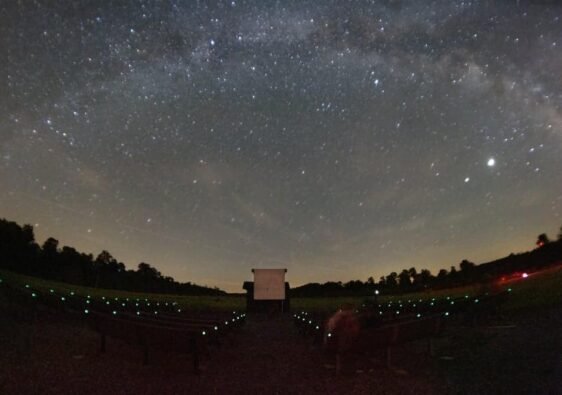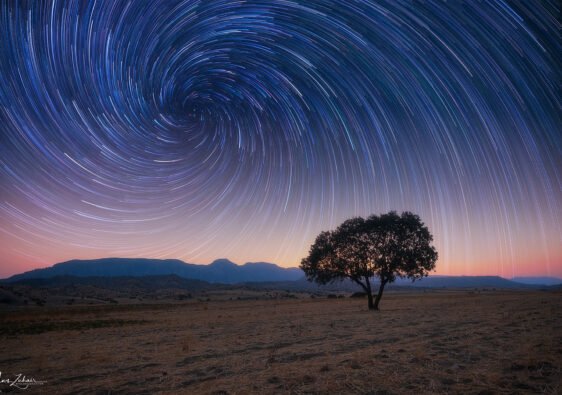
Transform from stargazing curious to cosmic explorer with this beginner-friendly gear guide
Starting your astrotourism journey can feel overwhelming. Which telescope should you buy? What apps actually work? How do you stay warm during those long winter stargazing sessions?
After helping hundreds of beginners take their first steps into astrotourism, I’ve identified the 15 essential items that make the difference between a frustrating night of squinting at darkness and an unforgettable cosmic adventure.
The best part? You don’t need to spend thousands of dollars. This complete starter kit costs under $800 and includes everything you need for your first year of stargazing adventures.
Why These 15 Items Make or Break Your Astrotourism Experience
Most beginners make the same costly mistakes: buying the wrong telescope, forgetting about comfort, or neglecting safety gear. This curated list eliminates guesswork and ensures every purchase directly improves your stargazing experience.
Each item has been tested by real beginners and selected based on three criteria:
- Ease of use for complete novices
- Value for money – no overpriced gadgets
- Versatility – works across different climates and destinations

ESSENTIAL #1: Red Light Headlamp
LHKNL Headlamp
Why it’s essential: Your eyes need 30 minutes to fully adapt to darkness. One flash of white light ruins everything and you’re back to square one.
What makes this special:
- Dedicated red light mode preserves night vision
- USB rechargeable (no dead battery surprises)
- 160-lumen brightness for setup tasks
- Hands-free operation lets you handle equipment
Beginner tip: Always use red light mode when reading star charts, adjusting equipment, or moving around. Your fellow stargazers will thank you!
Where to buy: Amazon, REI, B&H Photo
ESSENTIAL #2: Star Identification App
SkySafari 6 Plus
Why it’s essential: The night sky contains over 2,000 visible stars. Without guidance, you’ll spend more time confused than amazed.
What makes this special:
- Works offline (crucial for remote dark sky locations)
- Point your phone at any star for instant identification
- Shows real-time positions of planets and satellites
- Includes detailed descriptions and mythology
Free alternative: SkyView Lite (limited features but good for starting out)
Beginner tip: Download the app and try it in your backyard first. Practice finding major constellations before your trip.
Where to buy: Apple App Store, Google Play Store
ESSENTIAL #3: Beginner Telescope
Celestron 22452 StarSense Explore LT114AZ
Why it’s essential: Binoculars are great, but a telescope reveals details impossible to see with naked eyes – Saturn’s rings, Jupiter’s moons, lunar craters.
What makes this perfect for beginners:
- Smartphone integration guides you to celestial objects
- No complex setup or alignment required
- Lightweight (8.8 lbs) for travel
- Alt-azimuth mount is intuitive to use
What you’ll see: Moon craters, Saturn’s rings, Jupiter’s four largest moons, star clusters, nebulae
Beginner tip: Start with the moon – it’s bright, easy to find, and incredibly detailed through even a small telescope.
Where to buy: Amazon, Telescope.com, B&H Photo
ESSENTIAL #4: Astronomy Backpack
Lowepro ProTactic BP 450 AW II
Why it’s essential: Regular backpacks don’t protect delicate optics or organize astronomy gear efficiently.
What makes this ideal:
- Customizable dividers protect telescope and accessories
- Weather-resistant for unexpected conditions
- Multiple access points for quick gear retrieval
- Comfortable for long hikes to dark sky locations
Beginner tip: Pack heavier items (telescope, tripod) closest to your back for better weight distribution.
ESSENTIAL #5: Physical Star Chart
The Night Sky 30°-40° (Large) Planisphere
Why it’s essential: Phone batteries die. Apps crash. A physical star chart never fails and doesn’t emit light that ruins night vision.
What makes this special:
- Rotates to show exactly what’s visible on any date/time
- Large print readable under red flashlight
- Covers most of North America and Europe
- Indestructible plastic construction
Beginner tip: Spend 10 minutes before sunset getting familiar with the chart. Learn to orient it properly with north.
ESSENTIAL #6: High-Capacity Power Bank
Anker PowerCore 26800mAh
Why it’s essential: Remote dark sky locations often lack power sources. Your phone, red light, and other electronics need reliable backup power.
What makes this perfect:
- 26,800mAh charges an iPhone 6+ times
- Three USB ports charge multiple devices
- Fast charging input and output
- Airline-approved for travel
Beginner tip: Charge it fully before every trip and bring a short charging cable to minimize cord management.
ESSENTIAL #7: Comfortable Viewing Chair
Helinox Chair Zero Ultralight Compact Camping Chair
Why it’s essential: Neck strain from looking up kills the stargazing experience. A good chair makes hour-long viewing sessions comfortable.
What makes this ideal:
- Weighs only 1 pound but supports 250 lbs
- Reclines for comfortable sky viewing
- Packs incredibly small for travel
- Breathable mesh prevents overheating
Beginner tip: Test the recline angle at home. You want to comfortably view 45-90 degrees overhead.
ESSENTIAL #8: Thermal Base Layers
Smartwool Merino 150 Base Layer Set
Why it’s essential: Temperatures drop 10-20°F after sunset, even in summer. Staying warm is crucial for enjoyable stargazing.
What makes merino wool perfect:
- Regulates temperature in varying conditions
- Doesn’t retain odors like synthetic materials
- Comfortable next to skin
- Moisture-wicking keeps you dry
Beginner tip: Layer system works best – base layer, insulating layer, wind/waterproof shell.
ESSENTIAL #9: Sturdy Tripod
BOSCH BT 150 Compact Tripod
Why it’s essential: Shaky photos ruin astrophotography attempts. A solid tripod is mandatory for sharp night sky images.
What makes this travel-friendly:
- Weighs 3.7 lbs but supports 17.6 lbs
- Folds to 15.7 inches for easy packing
- Carbon fiber legs resist temperature changes
- Quick-release system for fast camera mounting
Beginner tip: Test tripod stability by gently pressing down on mounted camera. No movement means sharp photos.
ESSENTIAL #10: Quality Binoculars
Celestron SkyMaster 15×70 Binoculars
Why it’s essential: Binoculars provide wider fields of view than telescopes, perfect for scanning the Milky Way and finding targets.
What makes these special:
- 15x magnification reveals incredible detail
- 70mm objective lenses gather lots of light
- Multi-coated optics ensure sharp images
- Great for both astronomy and daytime use
Beginner tip: Use the tripod adapter for steady viewing at high magnification. Hand-holding 15x binoculars causes shake.
ESSENTIAL #11: Emergency Safety Device
ZOLEO Satellite Communicator
Why it’s essential: Dark sky locations are often remote. Emergency communication could save your life.
What makes this critical:
- Two-way satellite messaging works anywhere
- SOS button connects to rescue services
- GPS tracking lets others follow your location
- 14-day battery life in tracking mode
Beginner tip: Practice using all functions at home. In an emergency, you need intuitive operation.
ESSENTIAL #12: Moon Filter Set
Celestron Moon Filter Kit
Why it’s essential: The full moon is 400,000 times brighter than most deep sky objects. Without filters, it’s blindingly bright through a telescope.
What’s included:
- 80% neutral density filter for comfortable moon viewing
- Variable polarizing filter for different lunar phases
- Color filters enhance surface detail contrast
- Standard 1.25″ threading fits most telescopes
Beginner tip: Start with the 80% filter on full moon, then experiment with lighter filters as the moon wanes.
ESSENTIAL #13: Waterproof Observation Log
Rite in the Rain All-Weather Journal
Why it’s essential: Recording observations improves learning and creates lasting memories of your cosmic discoveries.
What makes this perfect:
- Waterproof paper works in any weather
- Pre-formatted pages for astronomy observations
- Compact size fits in any jacket pocket
- Works with standard pens and pencils
What to record: Date, time, location, equipment used, objects observed, weather conditions, personal notes
Beginner tip: Sketch what you see through the telescope. Drawing forces careful observation and creates personal artwork.
ESSENTIAL #14: Touchscreen-Compatible Gloves
The North Face Etip Gloves
Why it’s essential: Cold fingers can’t operate smartphone apps or telescope controls. These gloves solve the dexterity vs. warmth dilemma.
What makes these ideal:
- Touchscreen-compatible fingertips
- Lightweight but surprisingly warm
- Grip palm prevents dropping equipment
- Machine washable for easy maintenance
Beginner tip: Size down slightly for better touchscreen response and equipment handling.
ESSENTIAL #15: Insulated Beverage System
Hydro Flask 32oz Wide Mouth Thermos
Why it’s essential: Hot drinks maintain morale during long, cold stargazing sessions. Caffeine helps maintain alertness for early morning planet viewing.
What makes this perfect:
- Keeps drinks hot for 12+ hours
- Wide mouth fits most coffee makers
- Durable construction survives outdoor use
- Doubles as hand warmer when filled with hot liquid
Pro tip: Fill with hot chocolate, coffee, or herbal tea before heading out. The warmth and caffeine boost make 3 AM Milky Way sessions much more enjoyable.
Your Shopping Strategy: 3 Smart Approaches
Option 1: All-At-Once
Best for: Serious beginners ready to dive deep
Pros: Complete system works together perfectly, bulk buying often includes discounts
Cons: High upfront cost
Option 2: Seasonal Building ($130/month)
Best for: Most beginners wanting to spread costs
Months 1-3: Core viewing items (telescope, chair, headlamp, app)
Months 4-6:Comfort items (clothes, thermos, gloves)
Months 7-9: Photography gear (tripod, filters)
Months 10-12: Advanced items (emergency beacon, specialty accessories)
Option 3: Budget Starter
Best for: Testing the waters before full commitmentI ncludes: Budget alternatives for 8 most essential items Upgrade path: Replace budget items with premium versions as interest grows
Bonus: Where to Find the Best Deals
Amazon
- Frequent sales on astronomy equipment
- Prime shipping crucial for last-minute trips
- Customer reviews help verify quality
B&H Photo
- Professional-grade equipment
- Expert customer service
- No sales tax in most states
REI
- Excellent return policy (1 year, no questions asked)
- Member dividends (10% back annually)
- Local stores for hands-on testing
Direct from Manufacturers
- Warranty service directly from source
- Sometimes exclusive colors/models
- Best customer support
Seasonal Sales to Watch:
- Black Friday/Cyber Monday: 20-40% off most items
- Back-to-school (August): Educational telescope discounts
- Post-Christmas: People return unwanted gifts, creating deals
- Spring clearance (March-April): Making room for new models
Your Next Steps
- Start with the Core Kit – These 7 items provide 80% of the stargazing experience
- Test locally first – Master your gear in familiar surroundings before traveling
- Join online communities – Facebook groups and Reddit provide ongoing support
- Plan your first trip – Pick a dark sky location within 2 hours of home
- Document everything – Photos and notes create lasting memories
Remember: The best astrotourism gear is the gear you’ll actually use. Start with quality basics, learn what you enjoy most, then expand your kit based on your developing interests.
Whether you’re drawn to planetary observation, deep sky photography, or simply lying back and contemplating the cosmos, this starter kit provides everything needed for a lifetime of stellar adventures.
Ready to begin your cosmic journey? Start with the Core Kit and add items as your passion for the night sky grows. The universe is waiting!



